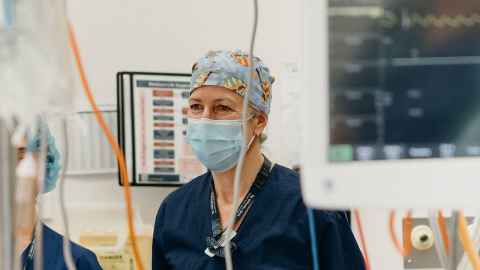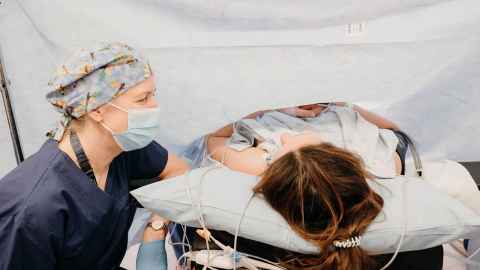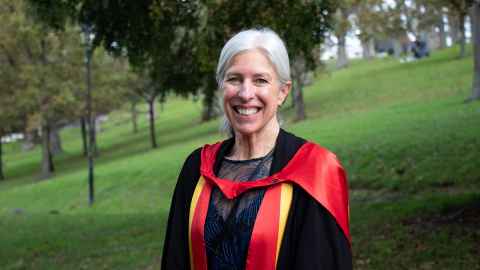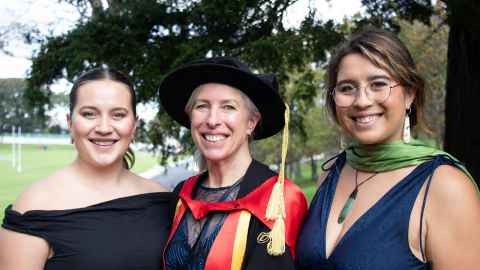Midwife’s pioneering PhD promotes evidence-based post-birth anaemia care
14 May 2025
A senior New Zealand midwife is waiting for news on funding the next stage of her groundbreaking research into treating new mothers with anaemia.

Esther Caljé remembers the moment in her career when her interest was piqued in intravenous (IV) iron. It was 2011 and she was working at Christchurch Women’s Hospital in the post-caesarean recovery area and a doctor prescribed IV iron for a woman after birth.
“I didn’t know about it and neither did my colleagues. I found guidelines on the intranet for an older iron formulation, but when I audited our IV iron use I found we hardly ever used it.”
Caljé knew from her work as a midwife that anaemia impacts about a third of women after birth, and she had personal experience; she’d been anaemic herself after her second baby was born.
“I had a haemorrhage, like many women, and was just sent home because I was otherwise well. I struggled with fatigue for many months with a baby and a toddler. I was a new midwife at the time but I don’t remember anyone talking to me about taking iron or thinking about it myself.”
Two decades later there are different options. Blood transfusions have been in use for decades and now there are new formulations of IV iron which are safe and user friendly. IV iron has completely changed practice in the treatment of anaemia.
But when to use one or the other, or when to use both? The more Caljé delved into the topic, the more she realised there were huge gaps in evidence-based guidance around the best approach to iron treatment for both pregnant women and new mothers with anaemia.
“We aren’t consistent in the care we provide, within and between hospitals. There are no national guidelines in management of iron deficiency and anaemia for these women, and a number of key evidence gaps.”

For example, Caljé knew from experience that blood transfusion picked women up immediately, but transfusion is more expensive, uses our limited resources of donated blood and can have antibody risks for future pregnancies.
Could intravenous iron be more effective longer term, and in what circumstances should it be given instead of, rather than as well as blood transfusion?
The answer was no one knew for sure.
Caljé also saw a lack of consistency and clarity around what level of anaemia warranted treatment and how effective different treatments were for women in the short and longer term.
“We are often preoccupied with lab results – haemoglobin and ferritin levels. But no one was studying how women feel, what their energy levels are, and how they recover and breastfeed after different treatments for anaemia.”
Caljé wondered, could she be the one to provide that evidence? Her postgraduate study was born.
“I had a strong feeling that this was going to be my future. I really understood the implications clinically and through my own lived experience, and I was fascinated by the knowledge explosion in iron metabolism. But I felt like a real outlier – midwives in Aotearoa don’t tend to do clinical research. And it hasn’t been easy.”
I was terrified. I was presenting to people from many specialties and with so much expertise. But at the end I had a plan of steps to take towards a clinical trial, and an outline of my PhD.
Caljé lives in Christchurch, and her first two applications for funding to do her studies in the South Island were turned down.
Then she met Katie Groom, an obstetrician and preterm birth specialist at Auckland Hospital and an associate professor of maternal and perinatal health at the University of Auckland’s Liggins Institute.
Groom supported her to take her research idea to the ON TRACK Clinical Trial Development Workshop – something Caljé describes as like “a two-day Dragons’ Den”. Led by Groom, it is designed to help researchers get funding in the mum and baby research space.
“I was terrified. I was presenting to people from many specialties and with so much expertise. They look at your concept, you brainstorm it, you bring it back and discuss it again, develop it. It was really challenging, but at the end I had a plan of steps to take towards a clinical trial, and an outline of my PhD.
“I applied for funding for the third time and this time I got it. Because of the ON TRACK network workshop, my application to the Health Research Council (HRC) was strong – the HRC could see I had high calibre academics and clinical trialists on my team from the University of Auckland and that team would support me to deliver what I said I was going to deliver.”

Four years later, Caljé is well established in her role as a clinical researcher. Her work, including a “challenging but useful” systematic review on interventions for post-birth anaemia, has provided a critical foundation for a full clinical trial of optimal treatment options.
“Esther always had a clear vision of the problem she wanted to tackle, and about which she is passionate,” says Professor Frank Bloomfield, the University’s Deputy Vice-Chancellor of Research and Innovation. “One of her papers [on the Fatigue after Infusion or Transfusion Pilot Trial] was ranked in the top 10 percent of most-viewed papers published by the journal Transfusion in 2023.”
Katie Groom says Caljé has become “a true national leader” in her field.
“Research opportunities for midwives are, unfortunately, scarce in Aotearoa and probably even more so in the South Island,” she says. “Esther has come a long way over her PhD journey, developing amazing networks and positively engaging with all the key stakeholders.”
Midwives are always talking about clinical practice – we are curious, hard-working and intelligent and as part of multi-disciplinary teams in maternity care we provide a different perspective.
The next stage for Caljé, a self-described “late, early-career researcher”, is a multi-centre randomised trial to generate evidence about the impact of giving new mothers intravenous iron on its own, as compared to IV iron and a blood transfusion.
She has applied for $1.4 million of Health Research Council funding over three years and will find out at the end of May if she’s been successful. She has also applied for HRC funding another project around managing iron deficiency and anaemia in pregnancy.
In the meantime, she’s attending her graduation ceremony with her two daughters – one has just graduated with her law degree and the other is doing a PhD in biomedical engineering.

She remembers herself at her daughters’ age – working in hospitality and as a ski instructor, before being invited to be at the birth of a friend’s baby, which inspired her to train as a midwife.
“I feel like I’m a different kind of researcher to most. PhD students are often young whereas for me, my research has been majorly influenced by my life and clinical experience.
“When I started my research I already knew so much as a senior midwife. But I really wanted to find out about this topic, and I wanted to find out how to do research, so I could improve the care we provide to many women after birth.”
Caljé hopes her research will also encourage other midwives to do clinical research; has been invited to present at the biennial NZ College of Midwives conference in Hamilton this year.
“Midwives are always talking about clinical practice – we are curious, hard-working and intelligent and as part of multi-disciplinary teams in maternity care we provide a different perspective.
“But we often talk about these things in the corridors. Instead, I would love to see more midwives getting involved in research not just around professional issues, but around big-picture clinical issues.
“Clinical research is a truly rewarding path and I hope I can inspire others.”
Media contact
Nikki Mandow | Research communications
M: 021 174 3142
E: nikki.mandow@auckland.ac.nz
United Nations Sustainable Development Goals
The Liggins Institute supports:
- SDG 3 – Ensure healthy lives and promote well-being for all at all ages.